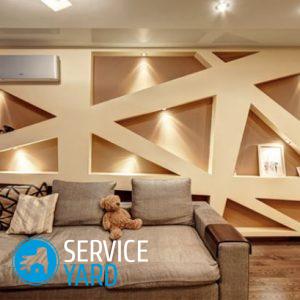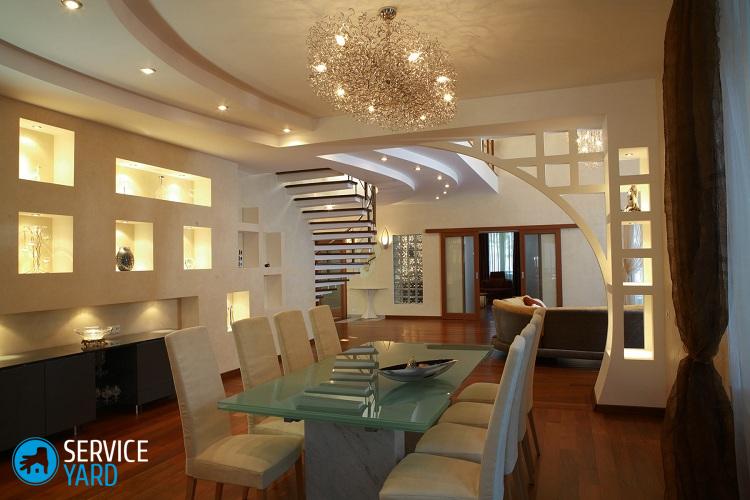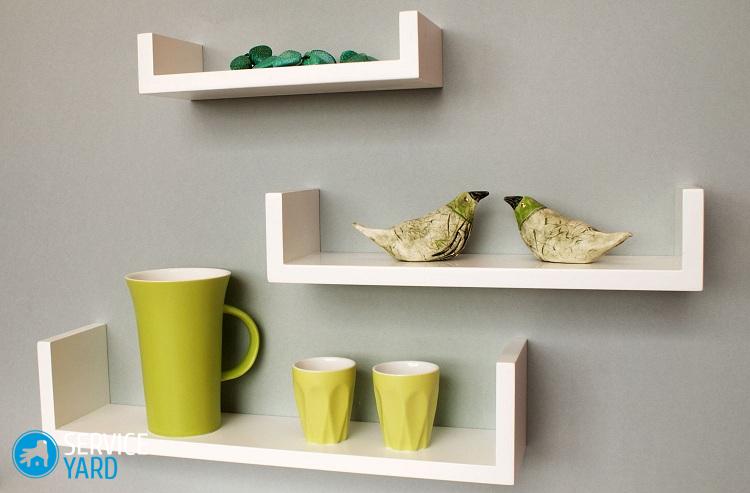Drywall shelves on the wall

The idea of building drywall shelves on a wall arose around the same time that this material began to be used for wall cladding. Why not create a pair of shelves where keys, books, vases, paintings, photos and other small decorative items are stored? Although, with a more thorough approach, such shelves can accommodate more bulky things, such as a TV, microwave, mini fridge and other household appliances. In any case, a wall with drywall shelves can help you solve the problem of storing a lot of things or just decorate a room. We will figure out how to make them and apply them in the interior, in this article.
to contents ↑The main advantages of drywall
At first glance, drywall, as a material, is not very suitable for creating shelves and niches, because its strength is in doubt. However, with the right approach to business, it will become obvious that the reliability of the shelf depends not only on sheets of drywall (GKL).

Let's look at the advantages of this material, which can talk about the possibility of creating shelves from it:
- Simplicity of work with GKL. With the help of improvised tools, the material is easily processed and any shape is attached to the product. It is enough to do everything carefully and carefully.
- Drywall is a very lightweight material. While carrying a whole sheet, it doesn't seem to you that this is so, but the shelves come out quite light. In addition, the frame for these shelves is made of a very light special metal profile. Therefore, the load on the wall is small.
- GKL surface can be decorated with various finish coatings, which will positively affect the organicity of shelves in the interior.
- Over time, the drywall shelves do not bend, remaining as smooth as when they were created.
- The cost of GCR is significantly lower than that of sheet materials made of wood, and even more so of solid wood. Price comparison is based on the cost of one meter of square material.
- When creating shelves, you can use not only new sheets, but also the remaining pieces after wall sheathing. In this case, it is necessary to carry out calculations so that the balances are at a minimum, which in the end will save finances.
Materials and Tools
When creating shelves at the same time as wall covering with drywall, you do not need to think about additional devices and fasteners. To create shelves from drywall with your own hands, the following materials are needed:
- Plasterboard sheets for living and walk-in rooms and moisture-proof for the bathroom.
- Galvanized profile.
- Guides wooden slats.
- Dowels with struts.
- Black screws.
Important! Finishing the shelves may require a primer, putty, spatulas, brushes and paint, but it already depends on your ideas.
You also need the following tools:
- a screwdriver, a drill or two in one;
- level, plumb line, tape measure;
- a grinder, scissors and a hacksaw for metal;
- drywall cutting knife;
- pliers, hammer.
to contents ↑Important! Not all of the above may come in handy. For example:
- If the drywall shelves on the wall are loaded with heavy objects, it is necessary to use metal profiles, which will increase the strength of the frame.
- If the shelves have decorative tasks and nothing heavy will stand on them, then a rack profile with ordinary guides will be enough.
Sketching and designing shelves
Before you make a shelf of drywall with your own hands, you need to imagine what it will be. There are a lot of options for the execution of shelves, and everyone must decide on their own choice:
- You can make long shelves or short shelves.
- You can make several of them, you can take them all over the wall.
- They can have an angular shape, as well as radial outlines.
The final option depends on personal preference.
Before starting the design, you need to find out what load the shelves must withstand. This affects not only the size of the selected profile in the frame, but also the thickness of the drywall. The thicker the sheet of drywall, the greater the load it can withstand. Standard sheet thickness for walls is 12.5 mm.
Important! If the shelves will have a purely decorative character, then the ceiling or arched gypsum board will come down, the thickness of which is 9.5 mm and 6.5 mm, respectively. These sizes can float, as they depend on the manufacturer.
Even the thickest drywall sheet can not withstand heavy loads. Therefore, pay attention to the selected profile from which the supporting frame is formed. It will bear the whole load. Of course, there is GCR, the thickness of which is more than 12.5 mm, but it weighs a lot and is quite rare, so it is better to pay attention to the reliability of the frame. For example, think over supports or correctly set stiffeners.
When you have exactly decided what you need to create, it's time to draw a sketch. The sketch should have a shelf in the form that it would look after installation.
The drawing will help determine the amount of materials needed to create a drywall shelf on the wall.
Important! The standard sheet width is 1.2 m, and the length can range from 2 to 3.5 meters.
After drawing the sketch, it will become clear what oversights were in your plan. Often the plan of the shelves changes, because what seemed to be in the head in the figure turned out to be completely different. And on the wall it may turn out to be completely unsightly.
to contents ↑Important! In the final project, the number of joints and joints should be minimal. This will greatly simplify the difficult task of building a shelf in the wall of drywall for a beginner.
Get rid of the emptiness in the corner
When we hear the word of the regiment, a rectangular design comes to mind. But the corner shelves from GKL have a more interesting look. In addition to their basic aesthetic purpose, they are used to fill the void in the corners of the room.
Important! Corner shelves, due to their design features, are stronger than their rectangular “counterparts”. So you can safely use them for their intended purpose, without fear that they will deform or bend.
Corner structures can be created without sides, which means that the consumption of materials will be less. It is better to sheathe the front part of the corner shelf with arched gypsum plasterboard (use the remains of this material, buying a new sheet will be irrational). Arched drywall is a very flexible material, which means that shelves can be made concave. Concave shelves look much more beautiful than if they were just triangular in shape.
to contents ↑Important! For shelf reliability, in addition to the frame, the GKL thickness plays an important role, which sheathes the top of the shelf. And for covering the bottom and sides of the shelf, you can use thinner and more affordable sheets.
Wireframing
The use of a metal profile and guides when creating the frame is the most important step in the design of the shelves in the wall of drywall. Literally everything depends on this stage. First, shelves are created from a metal profile and wooden blocks, and then they are sheathed with sheets of drywall. Let's delve into this process in more detail.
There are two common ways to assemble a frame under shelves:
- Shelves are laid in the wall design before plasterboard plating. In this case, the frame is constructed taking into account future shelves.Then niches in the wall are simply made, which are sheathed sequentially with the wall. However, this is not entirely suitable for us, because niches have a slightly different application than shelves.
- A base is made under the shelf, which will protrude forward from the plane of the wall.
Important! It will not be superfluous to know the strength characteristics that structures from GCR can have. This information can be found on the manufacturer’s website.
Features of work:
- Creating a frame, it is necessary to mark on the wall. Having marked the places where the profiles will be attached, it is possible to achieve that the drywall shelves on the wall will be perfectly flat.
- The profile is fixed to the wall with dowels in marked places. The greatest load will be on the profile, which is attached to the wall in full length. Therefore, do not spare the dowels and use the rack profile.
- If the shelf is not made for decor and not narrow, then you need to use jumpers for greater strength of the frame. A guide profile is suitable for creating jumpers.
Connection profiles among themselves
To make drywall shelves on the wall with your own hands, you need to be able to attach rails to the rack profile. The rectangular frame is assembled from one profile and three guides. They need to be able to correctly interconnect. This is done in one of these ways:
- With the help of screws. Short metal screws are used. At the junction of the profile with the guide, they are fixed with two screws. Thus, four self-tapping screws are needed to fasten the wall and guide profiles to each other. Between themselves guides fasten by the same principle.
- Using a notch. The notch is a special tool that is usually used to temporarily connect two profiles to each other. He punches a coaxial hole in two profiles attached to each other, and slightly bends the metal. Due to this, metal profiles are kept together. This method is good because no burrs appear, and drywall sheets fit snugly against the frame. Two slots in one joint will be enough for optimal structural rigidity.
Important! To increase the strength of the frame, vertical struts can be used. In this embodiment, the guides will be attached to the uprights and have support without sagging in the air.
At this point, use a plumb line or level to control the verticality of the racks.
to contents ↑Fixing drywall to the frame
After the frame is ready and securely attached to the wall, it is necessary to start lining it. This is a very simple task that does not cause such difficulties as in the case of creating a framework:
- First of all, a sheet of drywall needs to be cut according to the size of the shelves. Calculate and arrange the parts in advance on a sheet in order to avoid overspending the material. Drywall shelves will be even if the cutting on a large sheet is done carefully so that the edges do not crumble.
Important! So that the screws do not fall deep into the cast, you can use a special bit for a screwdriver. This is a bit that has a limiter. When twisting the self-tapping screw, the bit will rest against the drywall sheet so that the self-tapping head is flush with the sheet.
- For fastening drywall to a metal profile, 3.5mm screws are used, with a step every 15-20 cm. The standard length of the fastener should not exceed 25 mm. However, it is better for beginners to take longer screws - 35 mm, albeit more expensive. The fact is that self-tapping screws can move the sheet from the profile and bend it. This often happens with inexperienced craftsmen who have not yet mastered working with the GCR. For this reason, the minimum screw length may not be enough.
- It is better to screw self-tapping screws one after another, not in different places to fasten faster GKL. If you attach the screws in series, there will be less chance to push the profile, because there is already a holding bracket nearby.
Shelf Finish
How to decorate drywall shelves on the wall? A wide variety of materials are suitable for this, but most often they are coated with paint or wallpaper.
Using wallpaper
Wallpapering is very difficult and long.It will take a lot of nerves and time, but the result may not be achieved. Although with proper dexterity, if you cut and hide everything, it can turn out beautifully. At the same time, the wallpaper perfectly hides the drywall cracks, if they arise. Usually use wallpaper for painting.
Paint application
For painting shelves immediately it is better to take a water-based paint. When choosing thick paint on the surface, you can create a variety of patterns and textures. In any case, before painting the shelves they need to be prepared:
- All joints, hats of self-tapping screws are putty.
- At the joints of the sheets a right angle is displayed. It is the putty that makes the shelves perfectly flat.
- To make the edges more durable, they are reinforced with painting corners, which are fastened with putty.
- After drying, the fillers pass along the surface with sandpaper until a perfectly even horizontal surface is removed.
- Cleaned from dust and coated with a primer.
- Next, paint is applied.
Stock footage
Shelves of drywall on the wall - not just a good solution in the repair, but also a way to diversify the design of any interior. At the same time, making them yourself is not so difficult. The main condition for the successful implementation of this project is compliance with construction standards and a conscientious approach to work. After going through all the stages - from the sketch to finishing the finished shelf, an excellent product will appear that will please the eye and perform its functions well.
- How to choose a vacuum cleaner taking into account the characteristics of the house and coatings?
- What to look for when choosing a water delivery
- How to quickly create comfort at home - tips for housewives
- How to choose the perfect TV - useful tips
- What to look for when choosing blinds
- What should be running shoes?
- What useful things can you buy in a hardware store
- Iphone 11 pro max review
- Than iPhone is better than Android smartphones
















